Equity & Diversity Annual Report – 2018 Diversity Initiatives and Profile
The Reserve Bank's Diversity Profile
At the end of June 2018, the Reserve Bank employed 1,362 people. As with the 2017 data, the diversity profile in the Bank remains relatively stable overall. The numbers of Indigenous Australian employees and those who report they have a disability have been little changed (Graph 1). There has been an increase in both employees born overseas from a non-English-speaking background (NESB) and employees with parents from a NESB. Women held 44 per cent of positions, up 1.7 per cent in the last year and 34 per cent of management positions as at 30 June 2018, an increase of 2 percentage points from 2017.

Work-life Integration
Initiatives
The attraction and retention of skilled and experienced employees is affected by policies, practices and a culture that encourages and supports employees to manage their career and other life commitments. During 2017/18, the Flexibility ERG focused on normalising flexibility across the Bank with the development and improvement of guidelines, resources and information. This has been achieved through: the development of case studies designed to challenge the perception that flexible work arrangements relate only to women or parents of young children; the implementation of manager training; and a toolkit to assist managers to confidently approve and manage flexible work requests. These resources support a culture in which flexible arrangements are part of our routine way of working across all levels of the Bank. There has been a focus on encouraging the default view that any role can be flexible, while recognising that some roles might have limited flexibility. All requests for flexible work are given due consideration and supported wherever possible.
To assist employees with integrating work and personal commitments, the Bank also has an active health and wellbeing program. This includes:
- the continued provision of an Employee Assistance Program, which provides confidential professional counselling and support to employees and members of their immediate families, via phone and face-to-face meetings. The service was accessed by 85 employees and 21 family members of employees during 2017/18
- sponsoring a 30-day ‘Health Challenge’ program to promote healthy behaviours, in which 220 employees participated
- the provision of fitness facilities and classes at Head Office, as well as fitness arrangements for employees in interstate and overseas offices
- influenza vaccinations being made available to all employees at no cost
- training for managers and employees in recognising and addressing potential mental health issues.
The Bank has a number of initiatives to promote family-friendly workplace practices, including:
- the option to access a second year of parental leave as an employment entitlement
- providing a dedicated Parent's Room. This facility was re-accredited by the Australian Breastfeeding Association during the reporting period
- providing a ‘parental leave toolkit’ which informs employees of their entitlements and the resources available to support them before, during and after parental leave
- holding a series of information sessions for staff on recent improvements to the Bank's policy and guidelines on flexible working arrangements.
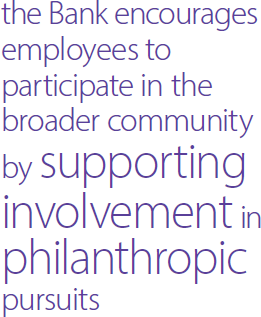
Consistent with the Bank's core value of contributing to the economic prosperity and welfare of the Australian people, the Bank encourages employees to participate in the broader community by supporting involvement in philanthropic pursuits in a number of ways. In particular, it matches all donations made by employees through the Bank's Benevolent Fund on a dollar-for-dollar basis. The Bank also has a Volunteer Day Program, where employees use a day of annual leave helping at an eligible charity, and the Bank donates to that charity the equivalent of one day's pay.
Profile
To help monitor work/life integration, the Bank looks at a number of different indicators, including:
- the take-up of part-time and other flexible work arrangements
- parental leave usage
- the use of carer's leave
- the take-up of the Bank's purchased leave scheme.
The Bank launched a Flexible Work Policy in August 2015. During the reporting period, the Flexibility ERG provided updated information session for managers and employees to raise awareness of the policy and highlight some revised resources, including a manager toolkit.
During 2017/18, 9.9 per cent of employees worked part time. This represents an increase from the previous year (Graph 3). More women than men are participating in part-time arrangements at a ratio of over 4:1. Some points to note about part-time employees include:
- 86 per cent of employees working part time do so for at least six days per fortnight (Graph 2)
- 8.4 per cent of Managers work part time.


There has been a slight increase in the number of employees working part time, up 1.2 per cent to 9.9 per cent. The number of female employees working part time has increased by 1.4 per cent, while males have decreased slightly.
During the reporting period, 17 women and 27 men commenced parental leave, representing 3.2 per cent of employees.
More men than women access parental leave (Graph 4). However women typically take a longer parental leave break than men. Over 80 per cent of men accessing parental leave take one month or less, whereas women typically take between six and 24 months, unless they are a secondary carer (Graph 5).


Upon their return, 85 per cent of women take up a part-time role. In the reporting period, one woman resigned after completing parental leave (Graph 6).

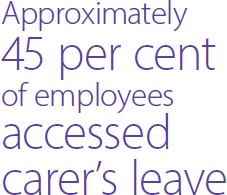
Approximately 45 per cent of employees accessed carer's leave in 2017/18, almost eight percentage points above the 10-year average (Graph 7). Men accounted for 61 per cent of those taking carer's leave, compared with 39 per cent women (Graph 8).
The Bank's Purchased Leave Scheme enables employees to request up to four weeks additional leave in a year. A total of 52 employees purchased extra leave during the reporting period, 35 per cent of whom also accessed the scheme last year (Graph 9). One-third purchased an additional four weeks leave and another one-third purchased two weeks leave (Graph 10). Two-thirds of users were in the 40-plus age groups.


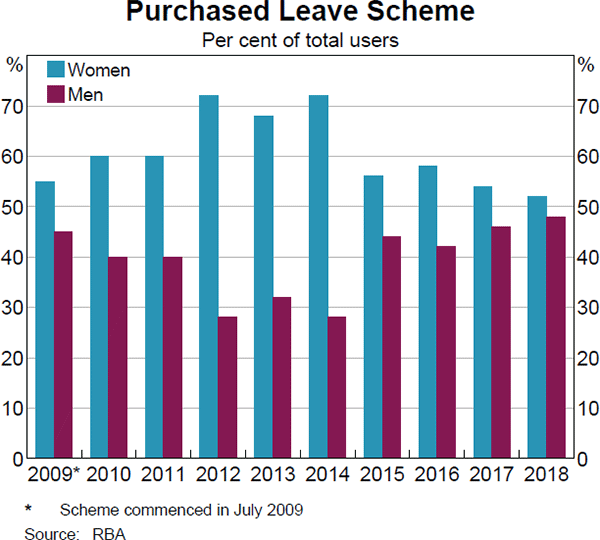
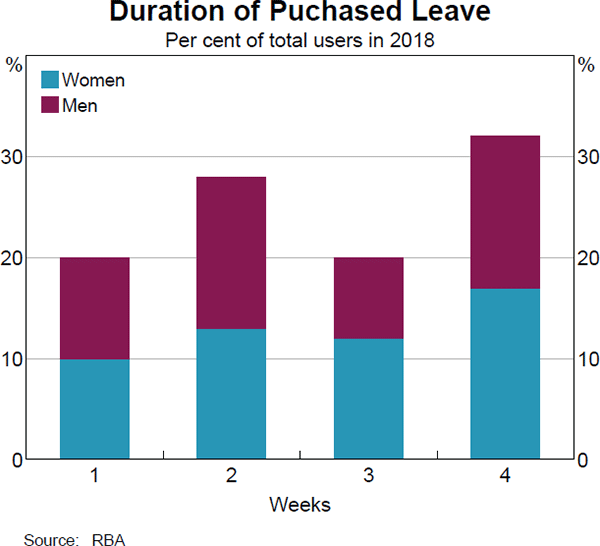
Gender
Initiatives
Comparable to the Australia-wide share of employment, 44 per cent of the Bank's employees are female (Graph 11). The representation of women in management at the Bank has typically been lower, but has increased in recent years. Eighteen per cent of women employed by the Bank are managers (Graph 12).
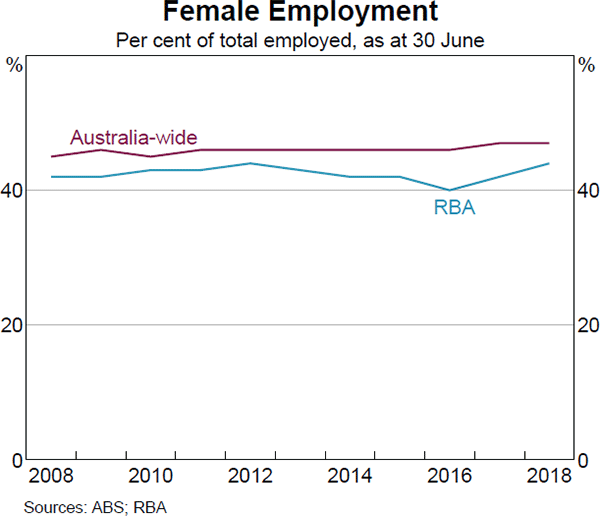
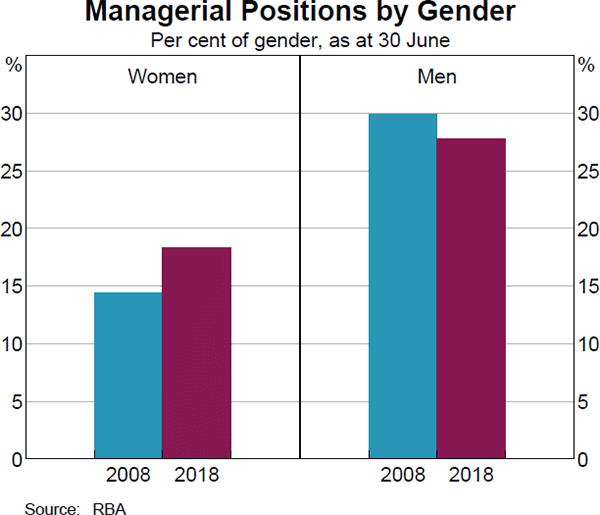
In April 2015, the Bank announced that a key commitment of its work in diversity and inclusion is to achieve the appropriate representation of women in management positions across the Bank. Women currently hold 34 per cent of management positions (Graph 13). To track our progress on this priority, a gender target was introduced of 35 per cent of managerial positions to be filled by women by 2020. In 2017, the long-term gender target was increased to 50 per cent. Ensuring that all candidates of merit are provided with equal career opportunities remains fundamental to selection and career advancement decisions.
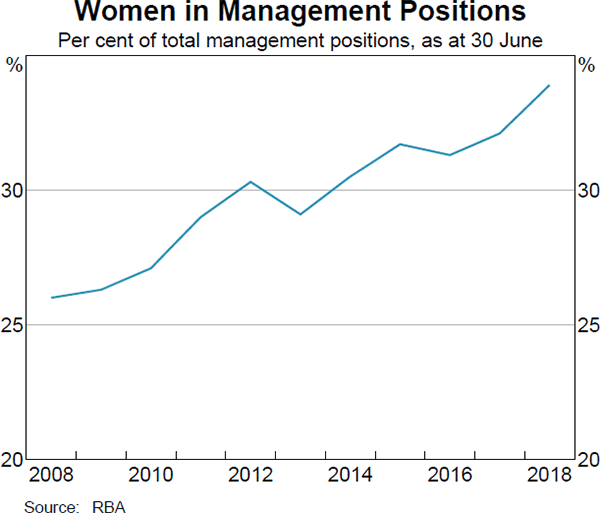
In addition, the Gender Equity ERG has organised events and provided information through the following initiatives:
- recognition of International Women's Day included a themed event, ‘Press for Progress’, to align with the day's theme. Guest speakers were Libby Lyons (Director of Workplace Gender Equality Agency) and Catherine Fox (journalist and author of Stop Fixing Women and 7 Myths about Women and Work)
- supported White Ribbon Day, aimed at preventing male violence against women, by providing information to employees and selling fund-raising ribbons in the staff cafeteria
- collaborated with other ERGs to research strategies to ensure recruitment, performance reviews and promotion processes are more gender neutral. This has contributed to changes in the way positions are advertised internally and externally
- worked with HR to create a primer to help managers in the Bank override their unconscious biases during the performance review process
- maintained a blog to provide an outlet for the research on such topics as Female Board Representation, Eliminating Everyday Sexism and Gender Equity Policy that has been done by members of the group
- further awareness of diversity and inclusion initiatives was achieved during the ERG Week Expo held in May. ERG members were able to share information about initiatives with colleagues and encourage support from people from all areas of the Bank.
Profile
Female Employment
At the end of June 2018, 595 women were employed at the Bank. This represents an increase of 1.6 per cent on the previous year, again reflecting, in part, the focus on actively recruiting and investing in a pipeline of female talent.
The continuing evolution of the Bank to being an organisation comprising of predominately professional staff has continued. The number of women in professional roles has risen each year since 2015. Of particular note, women now hold three of the five Assistant Governor positions at the Bank.
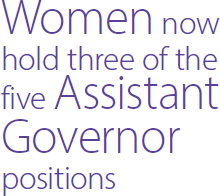
During the year to June 2018, 37 per cent of promotions were awarded to female employees, lower than both the female employment share (44 per cent) and the 10-year average (45 per cent). This result is the lowest result since 2009 (Graph 14).
Also, at the end of June 2018, women accounted for 50 per cent of total new recruits, notably higher than the 10-year average of 41 per cent (Graph 15). In the reporting year, the number of female graduate recruits exceeded the number of males for the first time. Fifteen female graduates commenced at the Bank in 2018, compared with 13 male graduates.
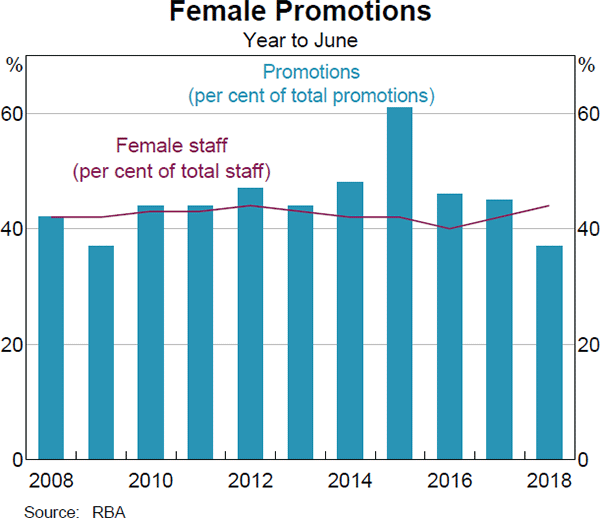
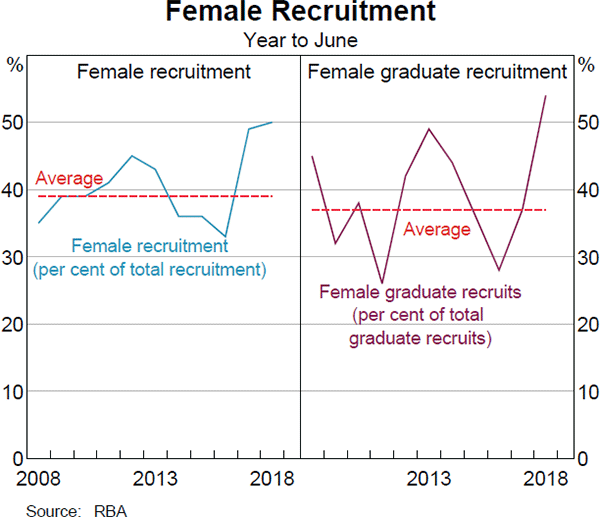
A total of 229 employees exited the business in the reporting period (including retirements). The majority of exits were in the 30–39 age group (78) and the 20–29 age group (58). Women accounted for 39 per cent of exits, less than their share of employment (Graph 16).
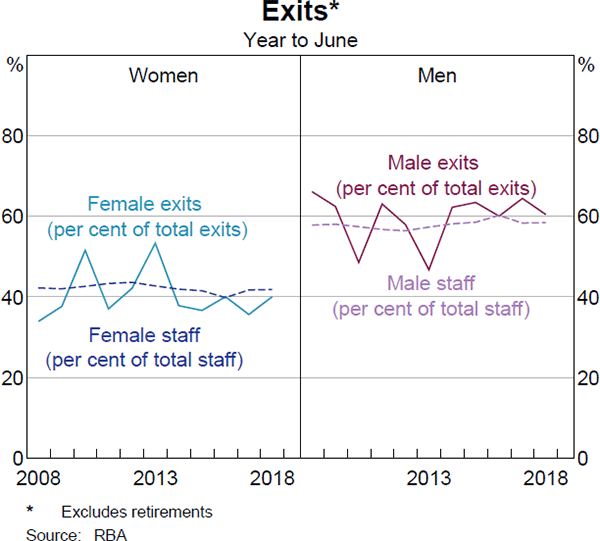
Continuing the focus on leadership development, the Bank partnered with Bendelta to develop and deliver the Engaging Leaders Program, aimed at Level 5 managers. The program focuses on self-awareness, leadership style and engagement skills. Participants also learn how to create a psychologically safe environment and take ownership of issues to achieve outcomes.
Age
Profile
The average age of Bank employees has remained steady at around 38 since 2008 (Graph 17).
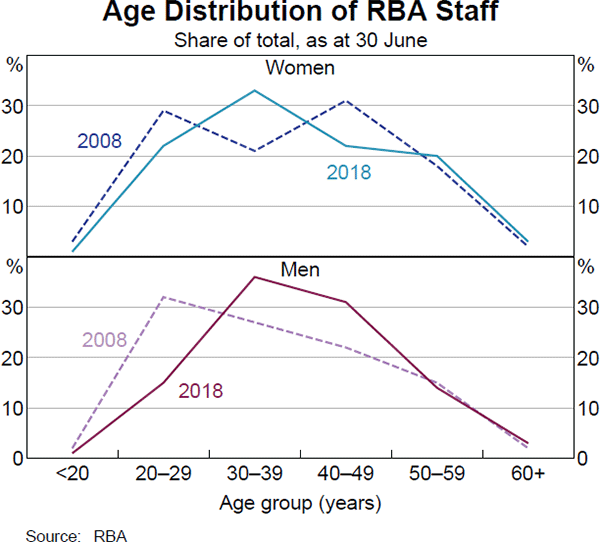
Compared with the overall labour force, the Bank has a relatively young workforce; 37 per cent of all employees are under the age of 35 and 69 per cent under the age of 45 (Graph 18). This is largely a result of the Bank's hiring practices; reflecting the role of the graduate, internship and traineeship programs, around one-third of hiring each year is of younger workers under the age of 25 (Graph 19).
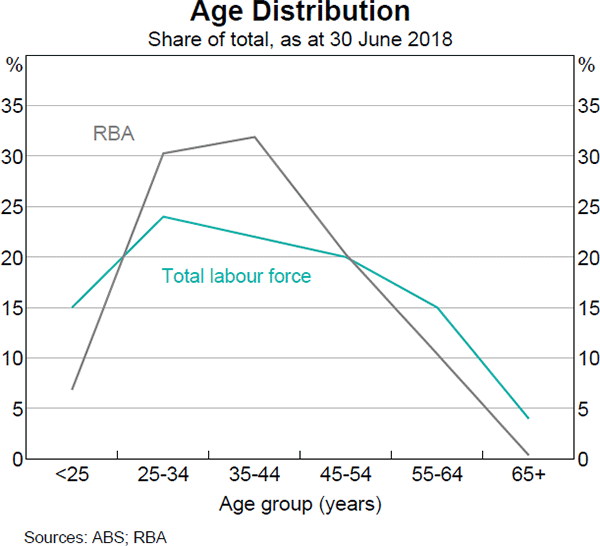
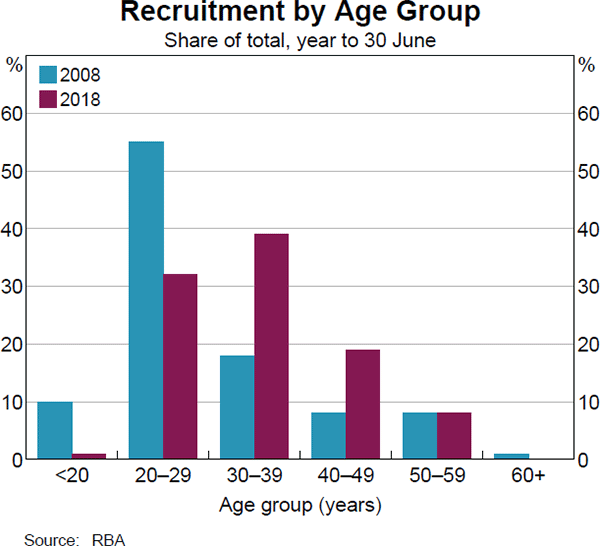
Employees eligible for retirement accounted for 9 per cent of exits during 2017/18. More than half of employees leaving the Bank do so before the age of 39. (Graph 20).
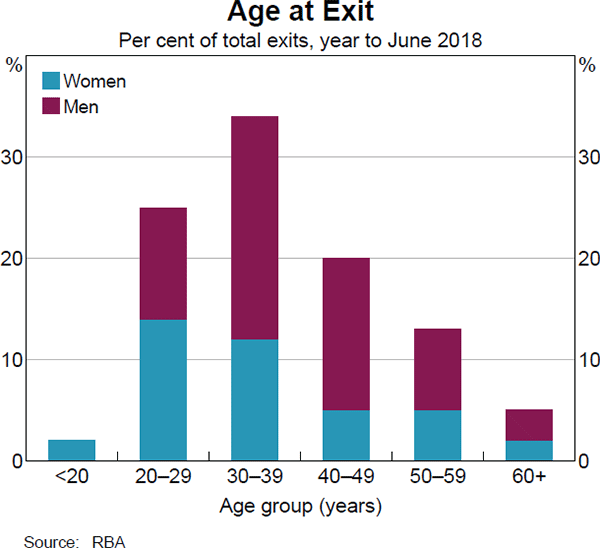
Lesbian, Gay, Bisexual, Transgender and Intersex (LGBTI)
Initiatives
The Bank has furthered its efforts to promote LGBTI inclusion in 2017/18. The LGBTI+ Allies ERG has continued its focus on raising awareness of LGBTI issues within the Bank, providing advice to the Bank on LGBTI workplace inclusion, and providing a safe and effective peer support network for LGBTI staff and allies. The Bank remains an active member of Pride in Diversity (PiD), a not-for-profit employer support program for LGBTI workplace inclusion, and sent a delegate to its annual conference and had staff participate in a number of member workshops and roundtables.
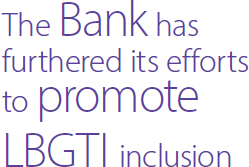
To assess the current state of LGBTI inclusion, the Bank participated for the first time in PiD's Australian Workplace Equality Index (AWEI), a national benchmark on LGBTI workplace inclusion. While the Bank achieved an overall score that was broadly in line with the average for other public sector organisations, the AWEI results also highlighted a number of possible opportunities to improve LGBTI workplace inclusion that the ERG is currently considering. Improving the Bank's ability to deliver targeted LGBTI awareness training to staff is one priority. The ERG has been developing options for LGBTI awareness training to be included as part of the Bank's general diversity awareness program.
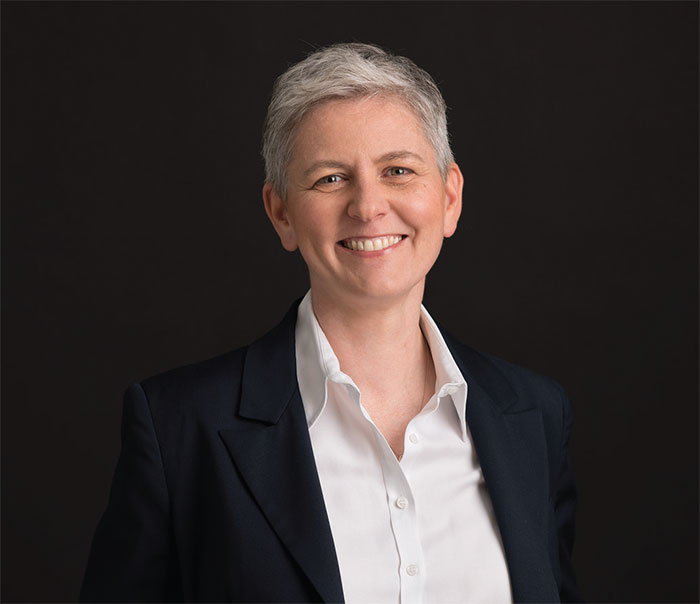
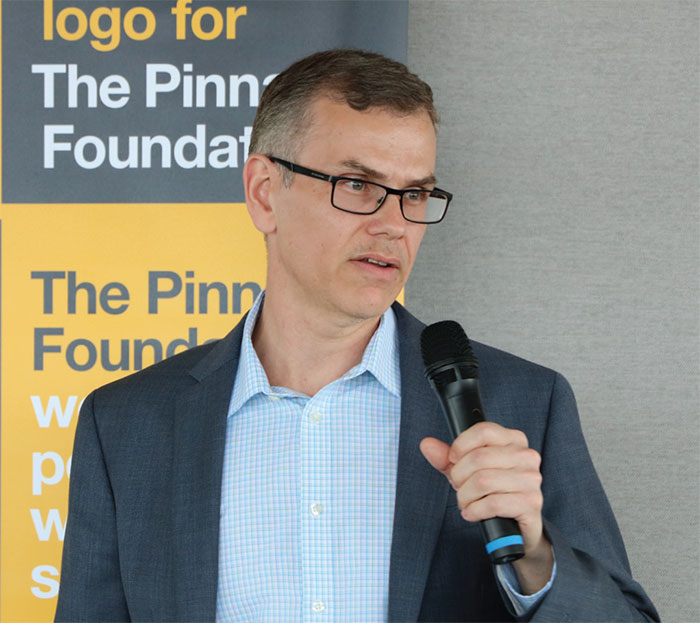
(From left) Assistant Governor Economic Luci Ellis (ERG LGBTI+ Allies Executive Sponsor) was announced as one of Deloitte's ‘Out 50’, a recognition of Australia's 50 outstanding LGBTI Leaders of 2018. Chris Thompson (right) Chair of the LGBTI+ Allies ERG speaking at a workplace inclusion discussion held at the Bank, Sydney November 2017
The ERG has continued to raise the Bank's LGBTI awareness through Bank-wide initiatives aimed at celebrating LGBTI days of significance, such as Wear It Purple Day and the International Day against Homophobia, Transphobia and Biphobia (IDAHOTB). These initiatives have helped inform and engage a growing group of allies and supporters within the Bank. The ERG has recently sought to galvanise this support through the launch of a broader RBA Pride Network for LGBTI staff and allies within the Bank.
ERG members have continued to engage with LGBTI staff networks at a number of other organisations, such as APRA and ASIC, to share experiences and learn about successful initiatives. Bank staff have also participated in meetings of an ‘Interbank LGBTI Network’ that brings together representatives from a wide range of financial sector organisations to share experiences on LGBTI workplace inclusion.
During the reporting period, the Bank hosted a panel discussion on LGBTI workplace inclusion organised in collaboration with the LGBTI staff networks at APRA, ASIC and the ATO and The Pinnacle Foundation. The external panellists were prominent businesswomen and LGBTI diversity advocates and the discussion was moderated by the Assistant Governor (Economic) Luci Ellis, who is the Executive Sponsor of the Bank's LGBTI+ Allies ERG. Bank staff also had the opportunity to participate in a number of similar events hosted by other organisations during the reporting period.
Further recognition was achieved by the announcement of Luci Ellis as one of Deloitte's ‘Out 50’, a recognition of Australia's 50 outstanding LGBTI Leaders of 2018. This list recognises individuals who are changing perceptions and creating more inclusive workplaces and communities.
As a way to raise the external profile of its LGBTI inclusion goals and attract talent, the Bank has established an online profile on the ‘LGBTI Inclusive Employers’ website hosted by PiD.
Disability/Accessibility
Initiatives
The Bank's Silver Membership with the Australian Network on Disability (AND) has allowed ongoing consultation with AND to refine our Accessibility Action Plan and seek guidance on best practice in the recruitment and employment of people with disabilities.
During the reporting period, there has been continued development and improvement of the Workplace Adjustments Guideline. In addition, access to information to assist all employees to enable accessibility features on devices used and make necessary adjustments to their own workspace.
AND have also provided the Bank with two interns as part of the Stepping Into program. This program provides university students with disability to complete a paid internship of a minimum of 152 hours during semester break.
Further awareness-raising was achieved during the ERG Week Expo held in May. ERG members were able to share information about initiatives with colleagues and encourage support from people from all areas of the Bank.
The ERG has organised events and provided information through the following initiatives:
- recognising United Nations Day of People with Disability by hosting a panel discussion attended by over 40 employees
- publishing an Accessibility Employee Resources Group Strategy brochure and other collateral, which have been distributed across the Bank
- delivering an Immersive Experience Workshop on Mobility in conjunction with Global Accessibility Awareness Day
- hosting the Accessibility and Web Development Meet-up, which included a presentation entitled ‘The Dark Side of Screen Readers’, delivered by Sean Murphy, Accessibility Software Engineer at Cisco Systems Australia Pty Ltd.
Profile
The proportion of employees who identified as having a disability was 2.1 per cent as at June 2018 (Graph 21). As data are provided on a voluntary basis, there may be some under-reporting and some employees may not wish to declare a disability.
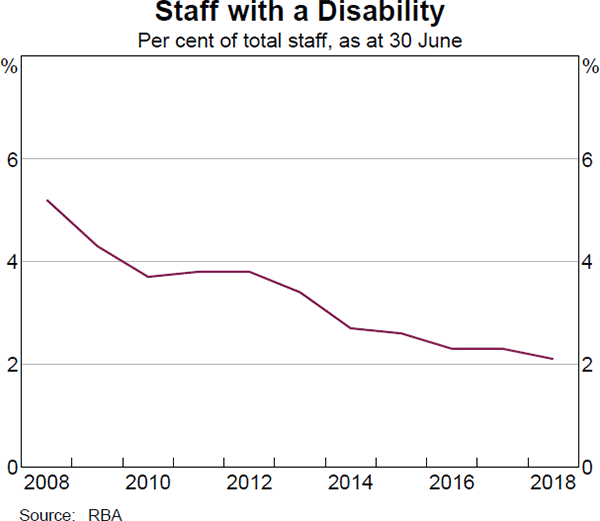
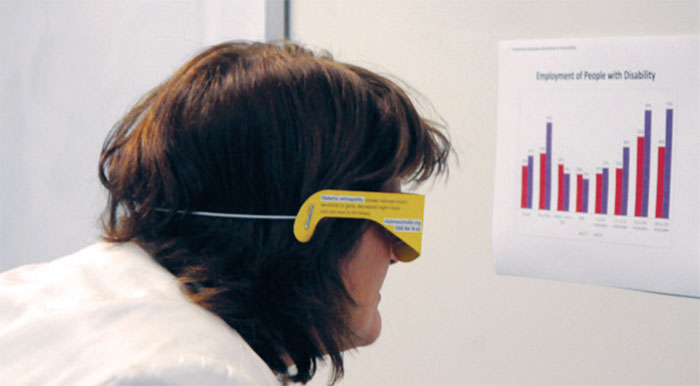
Indigenous Australians
Initiatives
To promote the inclusion of Indigenous Australians in the workplace, the Bank received endorsement of its Reflect Reconciliation Action Plan (RAP) from Reconciliation Australia in June 2018. Key commitments contained in the Bank's Reflect RAP include:
- developing an Aboriginal and Torres Strait Islander cultural awareness training strategy for staff
- establishing protocols for Acknowledgement of Country for key meetings and events at Bank sites
- developing an overarching recruitment strategy for which consideration is given to Aboriginal and Torres Strait Islander peoples
- providing a progress report on developing protocols for obtaining counsel and input from Aboriginal and Torres Strait Islander communities in the design of banknotes.
To raise employees' awareness on Indigenous Australian history and culture, the Bank celebrated National Reconciliation Week in 2018. The highlight of this was the permanent raising of the Aboriginal flag from the Bank's head office in Sydney and installing Aboriginal flags in public areas of all Bank locations. The Bank also celebrated NAIDOC Week in July 2017. This involved exhibits of Aboriginal and Torres Strait Islander works of art from the Bank's archival collections, and encouraged staff to view and learn the histories associated with these through educational talks.
Additionally, the Bank continued its focus on increasing the representation of employees from an Indigenous Australian background through a number of avenues, including:
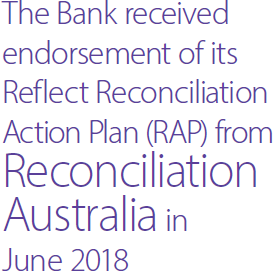
- the redesign of the Bank's Traineeship Program to facilitate the employment of Indigenous Australian school leavers as business administration trainees. In 2018, the Bank has partnered with My Gateway, a Campbelltown-based apprentice and traineeship support organisation dedicated to providing opportunities for Indigenous youth
- continuation of the Bank's internship for Indigenous Australian university students. In 2017/18, four students were recruited for internships across semester breaks. One of the 2017 interns has been offered a place on the Graduate Program upon completion of studies. The internship is facilitated by CareerTrackers, a non-profit agency that works with organisations to provide work experience, networking and professional development opportunities for Indigenous Australian university students. In 2018/19, the Bank will investigate expanding its participation in the CareerTrackers Internship Program
- Aboriginal Cultural Awareness training sessions were presented by an external expert consultant
- opportunities for Indigenous Australian applicants were highlighted when advertising the internship program on graduate job boards.
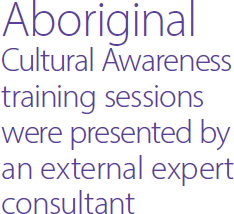
Indigenous Australians continue to account for a small proportion of employees, at 0.1 per cent (Graph 22). This is lower than the representation in the Australian community and the broader Australian workforce. It is, however, comparable to the proportion of Indigenous Australians working in occupational groups similar to those at the Bank. CareerTrackers interns are employed for fixed-term periods throughout the year and not all were employed as at 30 June. My Gateway Business Administration Trainees are employed by My Gateway and are not included in this count.
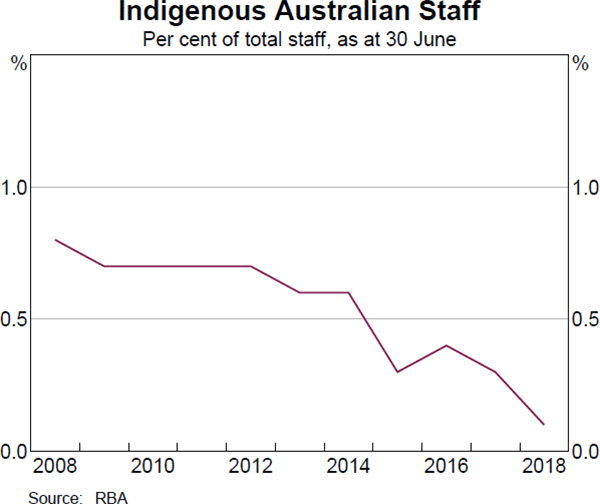
Race and Culture
Initiatives
The Race and Cultural Identity ERG continued to celebrate and raise awareness of cultural diversity and relevant topics across the Bank. In the past year, a variety of culturally diverse events have been celebrated at the Bank: significant policy-related work has been conducted through a Bank-wide discussion panel; participation in a leading industry leadership program; and collaboration on cultural research analysis with the Human Rights Commission.
In March 2018, staff from Head Office, Business Resumption Site and Craigieburn participated in Harmony Day celebrations. Staff shared food and stories from their different cultural backgrounds and, in doing so, celebrated the Bank's cultural diversity. The event took advantage of the significant national profile of Harmony Day in order to raise awareness of cultural diversity in the workplace and broader population.
In addition, throughout the year, the ERG has supported a variety of cultural days of significance including Lunar New Year, Diwali, St Patrick's Day and Australia Day.
In late 2017, the ERG hosted a Bank-wide panel discussion on the topic ‘Why does cultural diversity matter?’. Panel members included the Australian Race Discrimination Commissioner, a non-executive director of AMP as well as members of the Bank's senior leaders and staff. The discussion covered themes such as why diversity matters, the benefits of having a culturally diverse workforce and the importance of role models from diverse backgrounds. More than 100 staff attended the event.
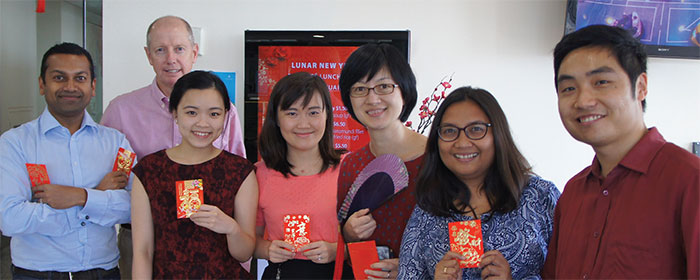
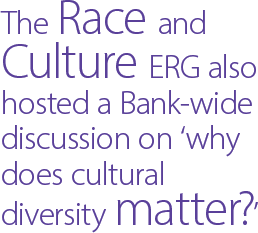
The ERG has also begun collaborations with the Bank's Gender Equity ERG and other government agencies and organisations on items of common interest.
In early 2018, members of the ERG worked with the Australian Human Rights Commission to obtain more accurate estimates of race and cultural diversity within the Australian population.
The ERG participated in an inaugural leadership program on cultural diversity facilitated by the University of Sydney. Bank-wide cultural awareness training is also being trialed for employees.
Profile
The proportion of Bank employees who identified as having been born overseas or from a NESB has been relatively consistent at around one-third of staff (Graph 23).
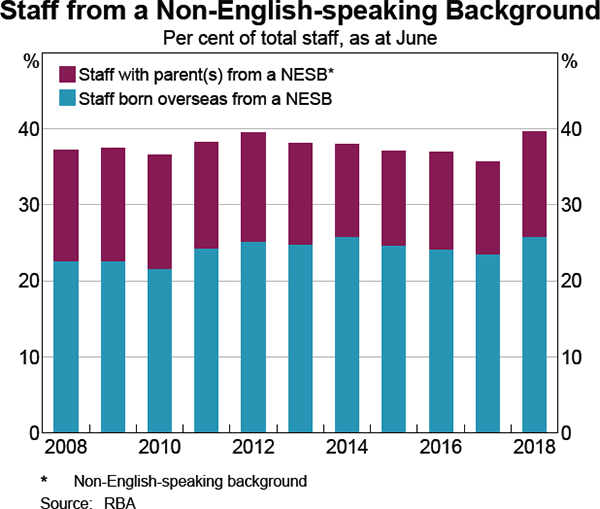
The representation of these employees at the Bank is significantly higher than their representation in the Australian community and is higher than that of the Australian workforce. Most employees from an NESB originate from India, China and the Philippines.
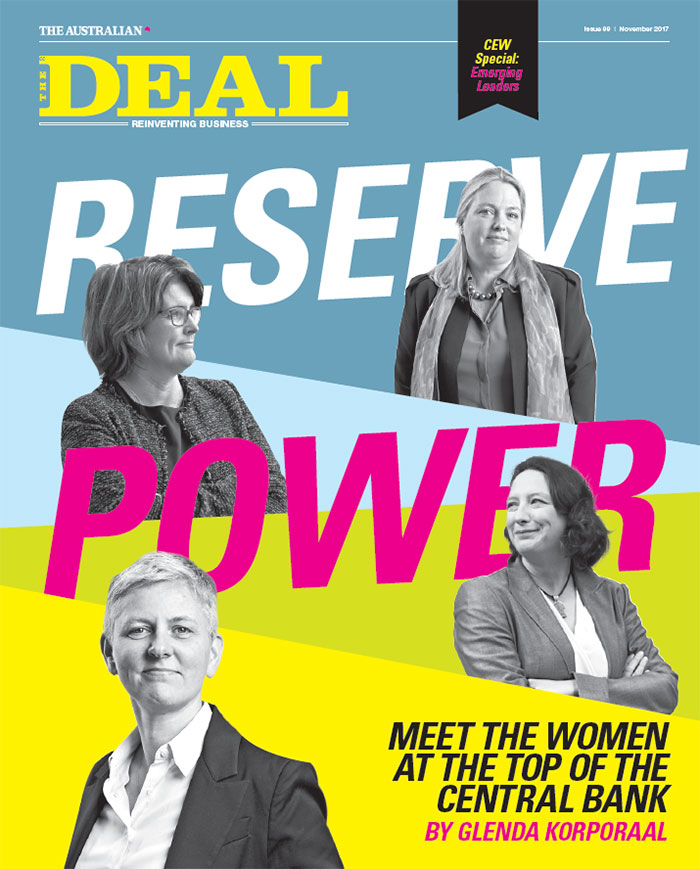
The Deal featured a number of senior women at the Bank including (clockwise from top left) Michele Bullock, Assistant Governor (Financial System); Marion Kohler, Head of Domestic Markets Department; Alex Heath, Head of Economic Analysis Department; and Luci Ellis, Assistant Governor (Economic)